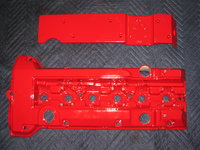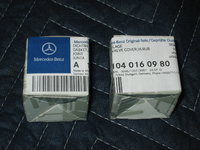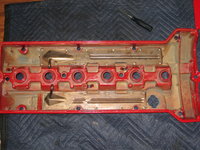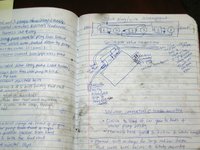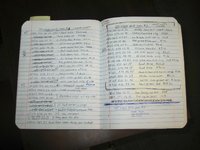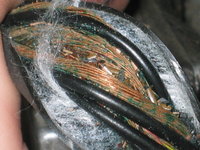Re: M104 / W124 Top-End Rebuild

I am sincerely sorry for the lack of updates the past couple of nights. Over the past couple of weeknights, I've put in a total of about 1.5 hours each night, but the time has been fairly productive time. The cylinder head is now removed from the car, and will be going into the machine shop on Friday (along with the lower (cast aluminum) part of the intake manifold, for refurbishment and clean-up.
I had a complication that threw me off for a bit, but I was able to overcome it. Namely, the cam bearing cap bolts (ALL of them) were torqued by the last mechanic extremely tightly, and/or Loctite was used on the threads of the bolts. These cam bearing caps are supposed to only be torqued to 21 Nm, but I was actually unable to remove any of the bolts even with a large breaker bar. In fact, I broke the tip off of one of my T40 Torx sockets attempting to remove one of the bolts, and came very, dangerously close to stripping out the heads on about 5-6 other bolts. So, I decided to stop where I was, and re-assess.
With the M104, the cylinder head can be removed from the block without requiring the camshafts to be removed (all 14 head bolts can be loosened and removed with the cam bearing caps still installed), so in the end I decided that rather than stripping out more bolts, and that I was going to be taking the head into the machine shop anyway, I'd just let them extract the bolts and remove the cams for me. Otherwise, I would carefully applied heat from a torch to loosen them by expansion, but it will be fine to have the machine shop take care of this task. This is in contrast to the M117, which requires that the cam towers be removed to access some of the head bolts.
Here's the update from the past couple of nights' work.
Here you can see my breaker bar and T40 Torx socket, attempting to break free the first of the cam bearing cap bolts. And you can see the resulting dead socket (exchanged at my neighborhood Craftsman tool store ... about 1.5 miles away....). It takes A LOT of torque to break off a socket this large, and I was still not able to budge the cam bearing cap bolt. It will be interesting to see what the machine shop finds, but I bet (based on what I saw on the front timing cover bolt threads) that the prior mechanic had used Loctite on those caps, and evidently torqued them down far more than the specified 21 Nm. I ordered 28 new Torx cam bearing cap bolts from MB -- they are around $1.50 apiece, so not too expensive.


Since I decided not to push my luck with permanently damaging the cam bearing cap bolts, and let Scroggins Machine take care of this, I elected to remove the cylinder head. It is held on with 14 XZN bolts (also known as "triple-square"). I obtained the MB socket (made by Hazet) for this task. The head bolts were on quite tight, but I was able to get them with not too much effort.
The head bolts have to be removed in stages, in the reverse order of installation. This means that you start at the rear corner (bolt #14) and work your way inward in sort of a circular pattern. I loosened each bolt about 1 turn, then moved on to the next one, and then started over and finished loosening and removing each one. My daughter Sofia helped me bag each of the head bolts in a marked bag. These will be replaced with brand-new bolts (which were ordered on Wednesday from MB), but I will measure the stretch of each of the old bolts to see if they are within the specified 3mm of stretch.

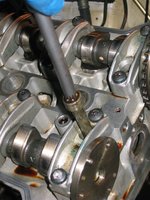

To remove the two rear-most head bolts, I opted to remove the central inner firewall section (this will be replaced due to damage, and will be on my final parts order as a cosmetic item) and the drains at the bottom of the windshield. When I re-assemble all of these items, I will replace the dust filters (seen in the photo below) with new ones from my stock, and I will lubricate the windshield washer arms with lithium grease. They are still decently greased from when I replaced the blower motor and regulator assembly several years ago, but "since I am in there" it makes sense to lubricate everything again.



Before removing the cylinder head from the block, after the head bolts were removed, there were a number of tasks that had yet to be performed. The first one, was the removal of the transmission fluid dipstick, which was held to the rear corner of the cylinder head by a single Allen bolt. This was fairly rapidly, but tediously, achieved, simply because the area was too tight to get an Allen socket in there, so I had to use the short end of an Allen key.



Next, the pin holding the upper timing chain guide rail (on the driver's side of the cylinder head) had to be removed, so I pulled out my trusty pin-puller (purchased and used for my M117 build several years ago) to slowly and carefully pull it out of the cylinder head.


That was about all for Wednesday night. Today (Thursday), a new day dawned, and after work I went out to the shop and got started about 7:30 PM. But before doing this, it was sort of an early Christmas at the Van Zandt home, with seven (yes, SEVEN) boxes arriving via FedEx from the cavernous parts warehouses of MBUSA, to my front hallway.

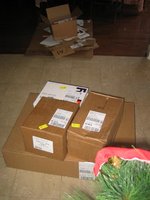
I was able to break the cylinder head loose from the block with my bare hands, but before I was able to REMOVE the head, one more task still remained. This was the removal of a plate on the rear, driver's side corner of the cylinder head, held on by two 5mm Allen bolts, that served as a bracket and also a nipple for one of the heater hoses coming from the firewall, to clamp onto. So, standing in the engine bay and kneeling on the top of the head, I loosened the ring clamp on the heater hose with a screwdriver, and worked the hose off of the nipple.
THEN, it was time to CAREFULLY lift the cylinder head off of the block. It was VERY HEAVY with the two cams still installed, but quite heavy even without them. And SO much larger than the M117 heads !! I lifted the head out, rested it temporarily on the fender and coolant reservoir (on top of an old pair of coveralls), clambered out of the engine bay onto the shop floor, and then lifted the head down and put it onto two plastic bags I'd laid out (on top of a moving blanket) on the shop floor.

Let's take a couple of looks at the block, immediately after the head was removed, as I pick off the used head gasket. The head gasket does NOT look to be the latest, corner-reinforced model that MB just sent me. I will do a detailed, side-by-side comparison later.



Here are some close-up photos of the insides of the cylinders, and the tops of the pistons and block. You can still see the cross-hatching in the cylinder walls, even after 202,000 miles.



The next task, was to finally remove the pesky EGR tube. Here I am lifting it out of the engine compartment (an easy job with the head removed; I need to remember to "re-install" it before replacing the head), and examining the inside of the intake manifold end of the tube. You can see that it is 80-90% blocked with carbon. I had reamed it about a year ago down THROUGH the throttle body, which unblocked it enough to stop the

lights, but it was only a matter of time before things built up again to be totally plugged.
I will soak the end of this tube in a gnarly solvent to loosen and then remove the build-up of carbon. I have decided NOT to purchase a new tube, as they are somewhere around $140.00 new...although I understand the design of the end of the tube has been modified to reduce or eliminate the periodic carbon build-up.



A few more views of the engine bay, after the head was removed.



You can certainly see the wetness on the rear of the block, underneath the passenger rear corner of the cylinder head. This is a CLASSIC location for oil leaks on the M104 (in addition to the upper timing chain cover at the "Bermuda Triangle" locations).

And, a few final views of the preparation of the cylinder head for transport to the machine shop. Specifically, removal of the bracket at the rear corner (the lower bolt is pretty much inaccessible due to the heater hose when it's connected), and the spark plugs removed from the head.




The refurbished fuel injectors are scheduled to be delivered from Deatschwerks in Oklahoma City tomorrow (Friday), so I will post the before and after reports on the flow and condition of the injectors. They called me on Wednesday to tell me that everything generally checked out fine and there were no problems.
The powder coater called and left me a message today to let me know that the valve cover and battery tray are ready for pickup, so I'll be stopping by on my way back from downtown Houston to drop the cylinder head and lower intake manifold at Scroggins Machine, to pick up those parts.
My replacement MB ETA (throttle body) will be delivered to my home next Tuesday. So, I am expecting that by next Friday, December 20th, I should have all of the pieces in place to begin re-assembly of the engine. My last parts order was made today, and will be delivered during the middle of next week. Everything is hopefully coming together, and my original estimate of 4-5 weeks of the car being down, is still holding up at this point.
While the cylinder head is in the machine shop, I have A LOT of cleaning work to do, not only on the exterior of the block, but also on the tops of the pistons and on the sealing surfaces on the front of the block, upper timing cover (both mating to the block as well as at the cam solenoid sealing surface), and general cleanup of the parts removed from the car. I'll be firing up my parts washer very soon.....
Til' next time!
Cheers,
Gerry

























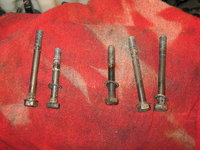













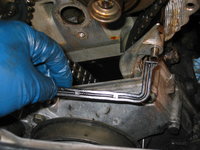
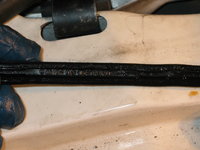


































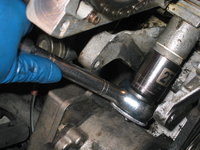




































 lights, but it was only a matter of time before things built up again to be totally plugged.
lights, but it was only a matter of time before things built up again to be totally plugged.

















